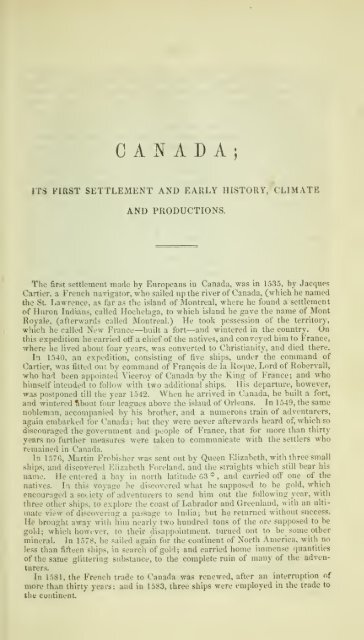Smith's Canadian gazetteer - ElectricCanadian.com
Smith's Canadian gazetteer - ElectricCanadian.com
Smith's Canadian gazetteer - ElectricCanadian.com
Create successful ePaper yourself
Turn your PDF publications into a flip-book with our unique Google optimized e-Paper software.
CANADA;<br />
ITS FIRST SETTLEMENT AND EARLY HISTORY, CLIMATE<br />
AND PRODUCTIONS.<br />
The first settlement made by Europeans in Canada, was in 1535, by Jacques<br />
Cartier, a French navigator, who sailed up the river of Canada, (which he named<br />
the St. Lawrence, as far as the island of Montreal, where he found a settlement<br />
of Huron Indians, called Hochelaga, to which island he gave the name of Mont<br />
Royale, (afterwards called Montreal.) He took possession of the territory,<br />
which he called New France—built a fort—and wintered in the country. On<br />
this expedition he carried off a chief of the natives, and conveyed him to France,<br />
where lie lived about four years, was converted to Christianity, and died there.<br />
In 1540, an expedition, consisting of five ships, under the <strong>com</strong>mand of<br />
Cartier, was fitted out by <strong>com</strong>mand of Francois de la Roque, Lord of Robervall,<br />
who had been appointed Viceroy of (Canada by the King of France; and who<br />
himself intended to follow with two additional ships. His departure, however,<br />
was postponed till the year 1542. When he arrived in Canada, he built a fort,<br />
and wintered ^bout four leagues above the island of Orleans. In 1549, the same<br />
nobleman, ac<strong>com</strong>panied by his brother, and a numerous train of adventurers,<br />
again embarked for Canada; but they were never afterwards heard of, which so<br />
discouraged the government and people of France, that for more than thirty<br />
years no further measures were taken to <strong>com</strong>municate with the settlers who<br />
remained in Canada.<br />
In 1576, Martin Frobisher was sent out by Queen Elizabeth, with three small<br />
ships, and discovered Elizabeth Foreland, and the straights which still bear his<br />
name. He entered a bay in north latitude 63 ° , and carried off one of the<br />
natives. In this voyage he discovered what he supposed to be gold, which<br />
encouraged a society of adventurers to send him out the following year, with<br />
three otlier ships, to explore the coast of Labrador and Greenland, with an ultimate<br />
view of discovering a passage to India; but he returned without success.<br />
He brought away with him nearly two hundred tons of tlie ore supposed to be<br />
gold; which however, to their disappointment, turned out to be some other<br />
mineral. In 1578, he sailed again for the continent of North America, with no<br />
less than fifteen ships, in search of gold; and carried home immense quantities<br />
of the same glittering substance, to the <strong>com</strong>plete ruin of many of the adventurers.<br />
In 1581. the French trade to Canada was renewed, after an interruption of<br />
more than thirty years; and in 1583, three ships were employed in the trade to<br />
the continent.

















